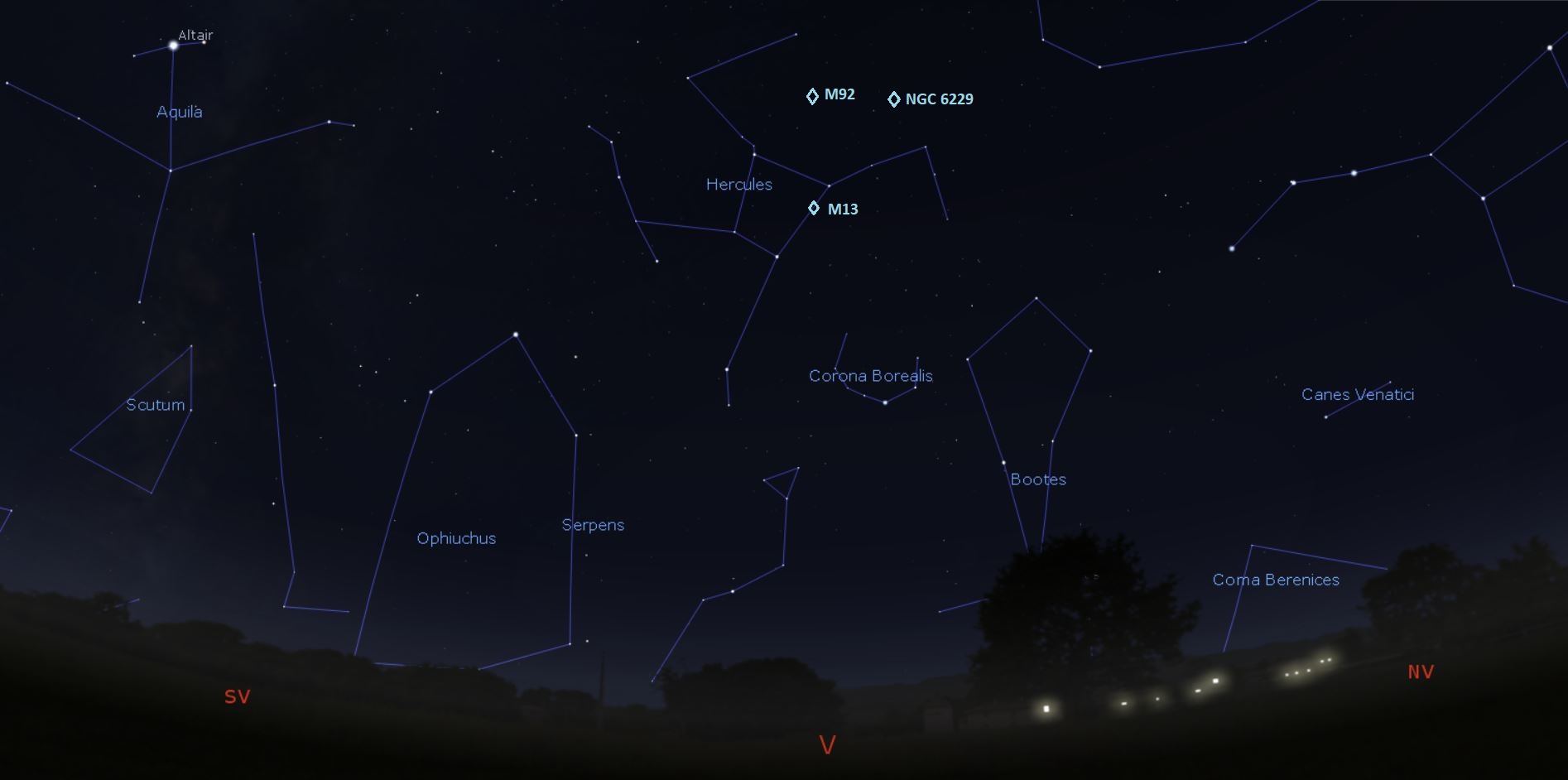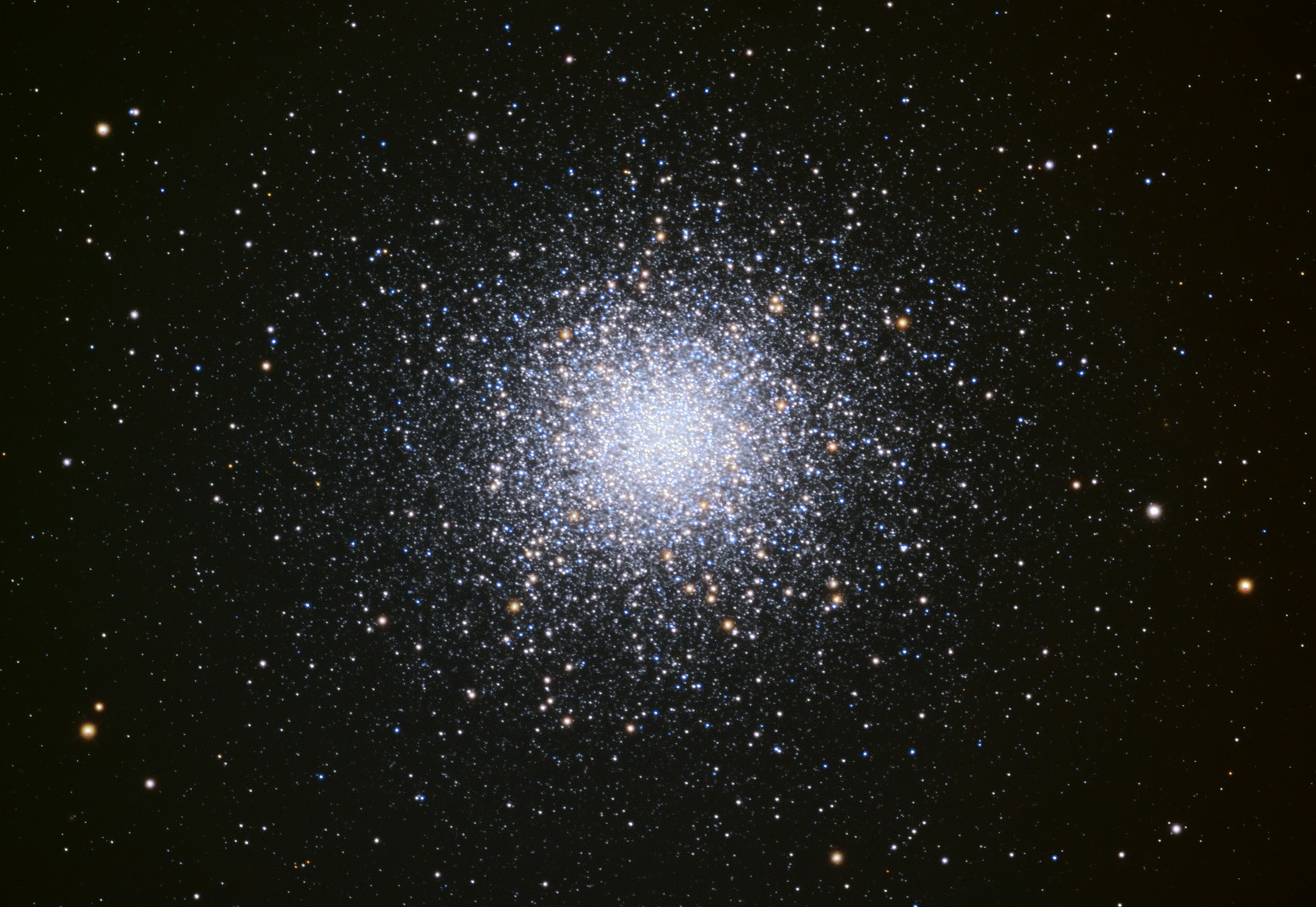Hercules is an easily identifiable constellation located well to the west in the autumn sky. The constellation got its name from the Roman god Hercules and it is easy to imagine the strong god with a wooden club in his fist.
For us amateur astronomers, Hercules is best known for the beautiful globular cluster M13. This issue of AstroInfo shows how this star cluster and two other clusters in Hercules are found and observed with telescopes and binoculars. An orientation map with the three star clusters highlighted is displayed at the bottom of the page.
The globular clusters are some of the most fascinating objects in the night sky. These are large star collections of stars that were formed at the same time as our own galaxy, the Milky Way, some 10 billion years ago. The size varies between ten and a couple of hundred light years and they can consist of up to a million stars. Most objects in the Milky Way that we observe with our telescopes are located in the galaxy's spiral disk. The special thing about the globular clusters is that they are located in a kind of halo in and around the galaxy, some 10,000 light-years outside the normal shape of the galaxy.
The dense accumulation of stars in the star clusters makes them bright and despite the large distances, many of them can be observed with an ordinary amateur telescope. There are about 150 globular star clusters in the Milky Way and at least 10 can be observed with a smaller telescope from our part of the earth.
The three globular clusters in Hercules (M13, M92 and NGC 6229) are marked in the orientation map at the bottom of the page. The map is focused on Hercules, which at 20:00 in the evening is a little over 30 degrees above the horizon. In November, it can be observed already at 6 pm in the west and then almost halfway to zenith in the sky.
Messier 13 can be seen with all types of binoculars, spotting scopes and telescopes. It is actually so bright that a young person with good eyesight can see the star cluster with the naked eye. The magnitude is 5.8 and that is approximately where the limit goes for what is observable without aids. As usual, of course, the farther away from cities and disturbing lights, the better the dimmer objects can be observed.
M92 is a slightly dimmer star cluster (magnitude 6.3) and has a brighter core and dimmer exterior.

The constellation Hercules is located in the west on autumn evenings in northern Europe and is easy to recognize. In Hercules there are three globular star clusters that you can see with a pair of binoculars or a smaller telescope (see map). Map made in Stellarium
Nevertheless, it is one of the brightest globular clusters in the northern sky. Often overlooked by amateur astronomers though, because it is so close to the more famous M13. Both M13 and M92 can easily be seen in a pair of binoculars on a dark and clear night. They appear as two misty spots.
With a spotting scope or a telescope, they will be more visible, the larger the focal length of the instrument and the higher the magnification. The great experience comes with the slightly larger telescopes - 6 inches in diameter and larger. With 100 times magnification and a larger telescope, you will be able to dissolve the star cluster in individual stars. Ml3 in particular is transformed from a hazy spot into a myriad of sparkling stars. In a larger amateur telescope, the M13 will look like the photograph on this page.
The third star cluster is NGC 6229, which is significantly dimmer than M13 and M92. The magnitude is 9.4 and that means you need a slightly larger telescope to see it. NGC 6229 contains two age generations of stars and some scientists believe that the star cluster may be a remnant of a spherical dwarf galaxy.
For those of you who plan to observe the globular star clusters in Hercules this autumn, it is recommended to read more about these and other star clusters. The more you know about the objects, the greater the experience at the telescope. A good place to start is English Wikipedia. A good search term on the web is "globular star dusters".
Feel free to use a planetarium program to print detailed maps to find the star clusters in the sky.

The globular cluster M13 in Hercules is easy to find, even in a pair of small binoculars. It contains around one million stars. With a larger telescope and high magnification many of the individual stars can be discerned. Photo: Sid Leach/Adam Block/Mount Lemmon SkyCenter.